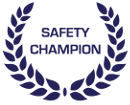
The Effectiveness of Your OHS Program
In today’s workplace, the safety and well-being of employees are paramount. Occupational Health and Safety (OHS) programs are designed to create a safe working environment by identifying and mitigating risks. This page aims to provide insights on evaluating the effectiveness of your OHS program using advanced software solutions like Safety Champion Software.
Understanding OHS Programs
An effective OHS program encompasses comprehensive policies, procedures, and training aimed at ensuring workplace safety. These programs are essential for compliance with legal standards and for fostering a culture of safety within an organisation. Integrating software into these programs can significantly enhance their efficiency and effectiveness by automating many of the processes involved.
Key Performance Indicators (KPIs) for OHS Programs
Key Performance Indicators (KPIs) are crucial in assessing the effectiveness of an OHS program. Some common KPIs include incident rates, near-miss reporting, compliance rates, and employee participation. Tracking these KPIs helps an organisation understand how well its OHS program is performing and where improvements can be made. OHS management software can streamline the tracking and analysis of these KPIs, providing valuable insights at a glance.
Evaluating OHS Program Effectiveness
Evaluating the effectiveness of an OHS program involves several methods:
- Audits and Inspections: Regular checks ensure compliance with safety standards and identify potential areas for improvement.
- Surveys and Feedback: Gathering employee input on the program’s effectiveness helps identify strengths and weaknesses.
- Incident and Near-Miss Analysis: Analysing incidents helps in understanding patterns and preventing future occurrences.
OHS software plays a vital role in facilitating these evaluations by providing tools for efficient data collection and analysis.
The Role of Technology in OHS Evaluation
OHS management software offers a range of features that support the evaluation of OHS programs, including incident reporting, compliance management, risk assessment, and training tracking. The benefits of using such software are manifold:
- Improved Data Accuracy: Automated data collection reduces errors.
- Enhanced Reporting: Software provides comprehensive reports for better decision-making.
- Real-Time Monitoring: Alerts and real-time data help in immediate response to issues.
Case Studies: Successful OHS Program Evaluations
- Company A: Reduced incident rates by leveraging OHS software for detailed incident tracking.
- Company B: Improved compliance through regular audits and feedback collection facilitated by software tools.
- Company C: Achieved comprehensive risk management by integrating advanced OHS software features.
Best Practices for Continuous Improvement
Continuous improvement is vital for maintaining an effective OHS program. Best practices include regularly updating policies, ongoing employee training, and utilising software for real-time insights. These practices ensure that the OHS program evolves with changing workplace dynamics and remains effective.
Enhancing OHS Program Effectiveness through Technology
Evaluating the effectiveness of your OHS program is crucial for ensuring workplace safety and compliance. By leveraging OHS management software, organisations can enhance their evaluation processes, gain valuable insights, and continuously improve their safety programs. Contact Safety Champion Software today to learn how our solutions can help you achieve these goals.



